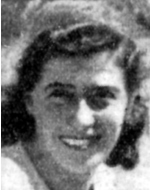Esther, daughter of Bluma and Moshe Dreisiger, was born on November 6, 1923, in the city of Milz, Poland. Daughter of a religious family. From the sixth year of her life, she was brought up in the home of her blind aunt and aunt in the town of Oswiecim in southwestern Poland. Her uncle’s house was also a Hasidic religious home. When she completed her studies at the Polish elementary school, he helped David in his trade. On the eve of World War II, about three and a quarter million Jews lived in Poland, who had already suffered from anti-Semitism many years before the war. In September 1939 the war began with the occupation of Poland by Germany, and in the following months the Jews were concentrated in the ghettos, with the most capable among them sent to forced labor. In the years to come, about 90 percent of Polish Jews perished in extermination camps. The largest camp was built near Oswiecim, the Auschwitz camp. All of Esther’s family, parents and adoptive cousins perished in the Holocaust. Only she was saved after she was transferred from camp to camp, stayed in Khajanov, then transferred to the labor camp at Unberg and from there to other camps until she saw the day of liberation. At the end of the war, when Esther found no trace of her family, Esther decided to join a pioneering training commune of the Ichud movement in Ostrowiec, near Kielce. In December 1945, Esther and her friends left the American zone of Germany and moved to Bergen-Belsen, which after the liberation became a kibbutz in the Bergen-Belsen DP camp. To the DP camp, where they planned to sneak across the German-Belgian border and join the pioneering concentration in Belgium, but were caught and tried for a few months in a prison in Hamburg and then moved to Landsberg in the spring of 1946. In Vilamadona, Esther joined the “Ayala” Bnei Akiva “On August 2, 1946, Esther and her group boarded the illegal immigrant ship” 23 Yordei Hasira “. The ship, which was organized by the Haganah’s Mossad Le’Aliyah Bet, sailed from the port of Boca de Migra in Italy with 790 immigrants. Upon reaching Cyprus, the ship was discovered by a British reconnaissance aircraft sent by a destroyer. The British sailors took over the ship and towed it to the port of Haifa. The immigrants began a hunger strike in protest against their expected deportation, but after a violent struggle they were taken to a deportation ship and taken to detention camps in Cyprus. At the beginning of 1947, Esther was released from the deportation. She arrived in Israel and joined Kfar Etzion, the first Gush Etzion settlement. Slowly she was absorbed in the place and in society. A few months after her arrival, Esther was married to Zalman Kaufman, a resident of Kfar Etzion, who was not included in the Jewish state in November 1947. Immediately afterward, the Arabs of the area launched attacks on the Gush In the following months, the block was besieged, with supplies arriving only in armored convoys or from the air, as did all the older settlers in the Haganah in the framework of the Etzioni Brigade, – and participated in guarding the village during the siege The Haganah reinforced the bloc with fighters from the Palmach Harel Brigade and from the Irgun’s Field Corps The Arab Legion began to attack the Gaza Strip before the end of the Mandate and the departure of the British from the country, and the attack began on May 12, 1948, when the Arab forces managed to occupy several outposts around Kfar Etzion. The next day, on 4 May 1948, the Arab forces launched an all-out attack on the village and stormed it. Esther and her friends, who were responsible for providing first aid, stayed in the shelter under the monasteryRamani in the village. The Legion was unable to penetrate the shelter, so it blew up the building and its inhabitants were buried under the rubble. Over one hundred defenders of the village fell that day, many were murdered after they surrendered. Among the fallen were Esther and her husband. The next day, on May 14, 1948, the day of the declaration of the state, the defenders of the other three Gush Etzion settlements: Revadim, Masuot Yitzhak and Ein Zurim surrendered, and the remnants of his defenders went to captivity. The remains of the fallen were left in place of their fall, the territory of Jordan, for a year or more, and their remains were collected in 1949 by a special operation of the military rabbinate. They were brought to eternal rest in a large mass grave on Mount Herzl in Jerusalem. ) The space is a “last scion.” The last survivor of the Holocaust is Holocaust survivors who remained the last remnant of their nuclear family (parents, brothers, sisters, sons and daughters) ), Who had personally experienced the Holocaust in the ghettos and / or the concentration and extermination camps and / or in flight and hiding in the territories occupied by the Nazis and / or fighting alongside members of the underground movements or partisans in the Nazi-occupied territories who immigrated to Israel during or after World War II, And fell in Israel’s wars.
